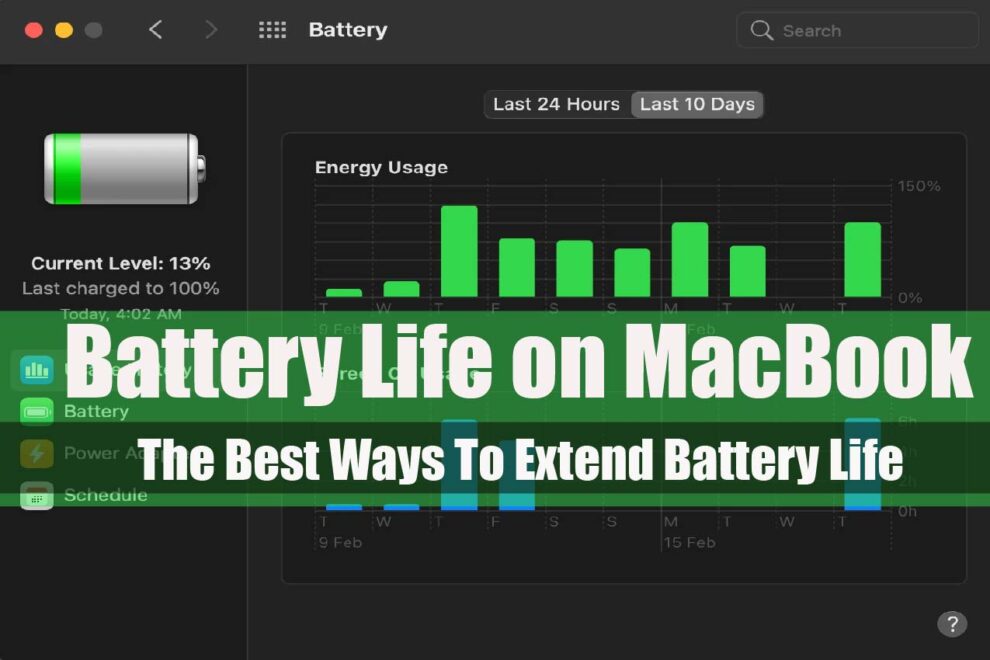MacBook battery problems can be many. Irrespective of what the manufacturer claims about the average battery life of a MacBook, variations in environment and usage affects the battery life. Even damages to the hardware components are risky to the battery. As such, battery life is not consistent.
No matter how durable and long-lasting a battery is, they all degrade over time. Applying simple tips and tricks can help extend the battery life of your MacBook. The primary intention is to use it healthily.
Every mobile device, say a smartphone or a laptop, works on rechargeable batteries. After a year of regular usage, the battery’s life significantly reduces. While the degradation of battery life is inevitable, several tips can at least extend the usability.
The latest MacBook models with Silicon M1 processors have considerably better battery power than the previous Mac variants. But that does not mean they won’t degrade over time after continuous charges. Besides following some practical tactics to use the MacBook battery the healthy way, there are also some settings in the system.
If you continuously use power-consuming programs or software on your Mac, the battery power will deteriorate much faster. Since different causes can lead to poor Macbook battery life, bugs or software is rarely the issue. The highest possibility still lies with unknown hardware errors or patterns.
Common ways that result in faster drainage of battery power to MacBooks are
- Over usage
- Active power-consuming apps or software.
- Wrong battery settings on the system.
- Charging the battery to the maximum every time.
- Malfunctioning wall adapter.
- The faulty battery is in poor condition.
- Battery charging at a maximum lower than 90%.
Finally, here are helpful tips and tactics to increase your MacBook battery life.
- Check the MacBook battery’s health.
- Optimize the battery charging limit.
- Update the macOS to the newest version.
- Activate the system’s energy-saving features and functions.
- Turn off keyboard backlights when not in use.
- Optimize the screen brightness.
- Keep the MacBook away from extreme temperatures.
- Turn off Bluetooth and other power-consuming factors when not in use.
- Switch to Safari instead of Chrome.
Regularly check Mac’s battery health in the system.
macOS has a function where you can check the battery life and overall health. To check your Mac’s battery report, follow the steps here:
- Go to the menu bar on the home screen and click on the “Battery” icon.
- Under it, click on “Battery Preferences.”
- Now, under the “Battery” tab, choose “Battery Health.”
- You will then see a pop-up window displaying your MacBook’s battery statics. For further queries, click on the “Learn more” option at the bottom of the screen.
If you want in-depth insight into your Mac’s battery history, you can check the charge cycles through these steps:
- In the home screen’s upper-left corner, click on the “Apple” icon.
- Then, click on the “System Information” while simultaneously pressing the “Option” key.
- That will launch the System Information app on the screen.
- On this app, look for the “Power” section, and under it, click on “Health Information.”
- That will show you the battery’s cycle count, health, capacity level, and many more aspects.
As for the MacBook battery charge cycles, the expected count is expected to be 1000. Exceeding this count of charge cycle means the battery needs replacement.
Keep the macOS updated to the latest version.
Previous macOS versions have some basic bugs concerning battery drainage and fluctuation issues. That severely affects Mac’s battery life and capacity. The newer macOS versions come with fixes to resolve the problems of the earlier versions. That is why you should keep updating your MacBook whenever a new operating system software update is available. Updating the software is better than costly battery replacement.
Also, Read – 5 Tips for Taking Better Care of Your MacBook
The updated and new optimization features in the latest macOS edition will help resolve and maintain healthy battery life. Apple is striving to utilize energy-saving technology in its products. You can manually update the software or set the automatic software update.
Enable all the useful energy-saving features.
Unwanted apps running in the background consume a lot of battery power. MacBook has a unique feature to optimize the battery-saving option through the Energy Saver section. Below are the steps to do so:
- On your MacBook, go to the main Menu.
- Select “System Preferences” from the options followed by “Battery.”
- Tick the box stating, “Slightly dim the display while on battery power.”
- Next, disable the Power Nap.
- Enable the options for “Optimize video streaming while on battery” and “Optimised battery charging.”
Turn off keyboard lights when not in use.
The backlit Keyboard in MacBooks is quite a helpful feature. Mac users love it. Using a Mac keyboard with its backlights on at night is simply wondrous. However, they do consume power. They drain battery power. So, when the device is inactive, keep the keyboard backlights off. When not needed, doing so will save a bit of battery power.
You can set a limit for turning off the keyboard backlights during inactivity.
- On your Mac, select “Keyboard” under “System Preferences.”
- Under the Keyboard tab, tick the box stating, “Turn keyboard backlight off after (X secs/mins) of inactivity.” The available duration options are 5 seconds to 5 minutes.
- While doing so, you should also adjust the option for “Adjust keyboard brightness in low light.” which will enable custom brightness settings.
Lower the screen brightness.
Using the Mac at its highest brightness level is a trigger point for fast battery drainage. It affects the healthy battery life. You can think of it as excessive sunlight unsuitable for the skin or a good tan. If you want to use your Mac for a long time, keep the screen brightness adequate at the right level. If you squint your eyes at the screen, the brightness is too high or too dim.
For new Macs with touch bars, adjusting the screen brightness is easy. For older MacBook models, you can alter the brightness level through the device’s System Preferences.
- From the main Menu, choose System Preferences.
- Select the Displays options.
- Under it, you will find a slider for adjusting the Brightness level.
- Or you can also do the same with the “F” key button on the Keyboard with tiny sun icons to lower or up the brightness. On MacBooks, these keys are usually F1 and F2 keys. Mac desktops are F14 and F15.
Avoid extreme temperatures.
Extreme temperatures are not suitable for any electronic device, be it a smartphone, laptop, or MacBook. Among many other externalities that affect battery health, extreme environments also significantly impact the battery. High cold or high moisture levels or too hot involves the sensitive elements in the battery cells.
MacBook batteries are overly sensitive even though the battery life per charge is long enough. Apple states that its battery has a specific comfort zone where it performs best. A harsh environment of 10 to 35 degrees centigrade is safe when using the device. But while storing the Mac, the battery will be inactive; about -20 to 45 degrees centigrade is considered safe. Other than that, avoid blazing sunlight or shivering cold.
Switch from Chrome to Safari browser.
If you are not aware, let me tell you that the Chrome browser is a power-consuming hog that takes up excess memory and consumes tons of battery power in no time. Switching to Apple’s Safari would be better if you are using the Chrome browser on your Mac. Since Safari is the default browser for MacBooks, they are capable and do not stress the battery.
Turn off Bluetooth and other power-consuming functions when not in use.
Connected Bluetooth speakers or Bluetooth feature drains the battery when on for a long time. It is better to disable it when not in need. Go to the Control Center icon from the Menu and select the Bluetooth option. Pull the switch there to turn off or on the setting.
You should also remove the connected USB drive after the work is done. That will prevent battery drainage.
Optimize the battery charging limit.
Always charging Mac’s battery to 100% is not good. That would damage the battery life, resulting in performance lagging and other severe Mac issues. But you can extend the battery life of your MacBook by optimizing or limiting the battery charging capability. Yes, macOS enables users to set or limit battery aging.
To optimize your Mac battery charging limit, follow here:
- On your Mac’s display, click on the Battery icon at the menu bar.
- From the drop-down menu, choose Battery Preferences.
- Click on Optimized Battery Charging from the options.
- Doing so will reduce your battery charging to 80% instead of 100%.
Bottom line
To conclude, here are various minor and significant tips and tactics to preserve your MacBook battery life. While some are quick and short-term, some are complex yet of better practicality. Either way, you should also note not to overcharge your Mac each time when plugged into the outlet.


















Add Comment